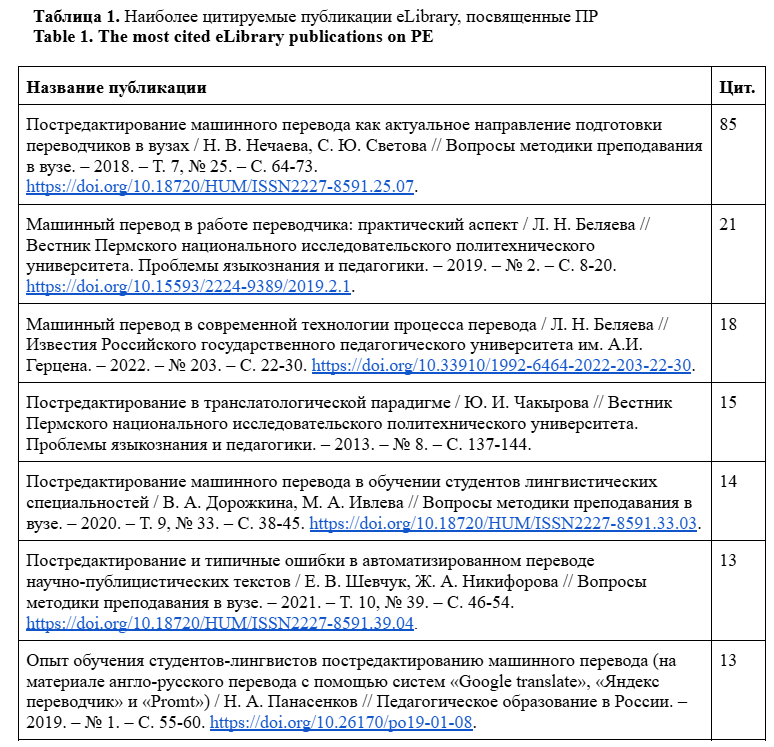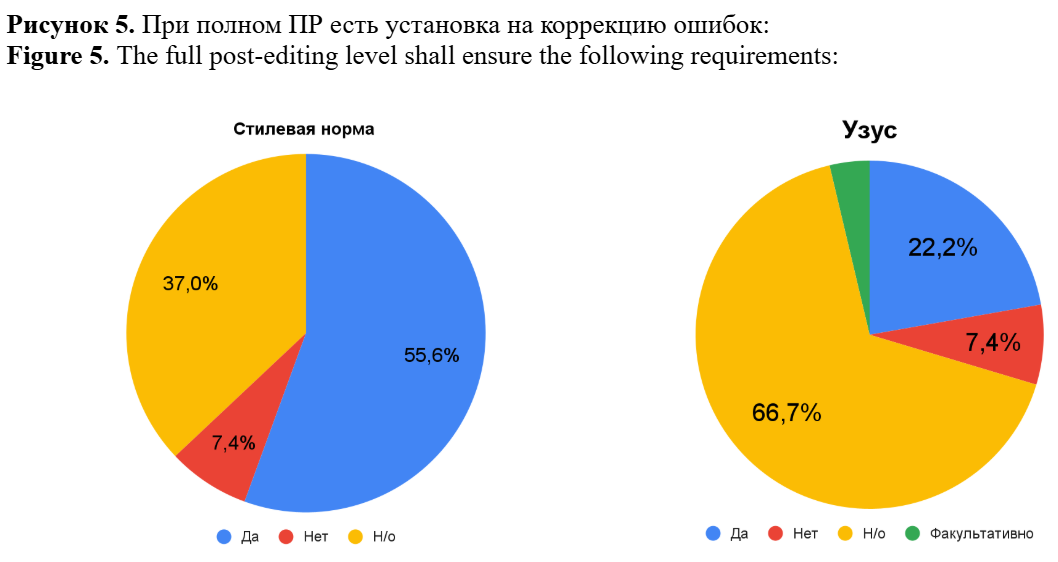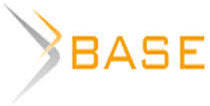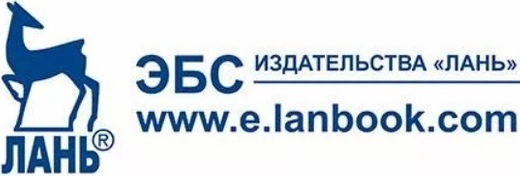Post-editing of machine translation in Russian scientists’ articles VS the International Standard ISO 18587:2017 – inner and outer divergences in the aspect of quality estimation criteria: literature review
Abstract: This article focuses on the views of Russian scientists on post-editing as a new type of professional activity in terms of the requirements to the quality of post-edited machine translation output. As there is currently no Russian version of the PEMT professional standard, and free access to the full text of ISO 18587:2017 'Post-editing of machine translation output' is not available, nor are industry brochures in English such as those of the TAUS association and RWS company sufficiently popular, up-to-date approaches to evaluating the final quality of translations edited by post-editors reveal fundamental differences in the very essence of post-editing. Our study shows that the most popular approach to PEMT in the Russian academic environment contradicts the relevant International Standard.
This lack of understanding what kind of professional activity PEMT is often leads to exaggerated requirements applied to post-editor’s output that do not correspond to the situation context. In order to assess the existing approaches and make the current situation clear, we set ourselves the following goals: (1) to perform a literature review of Russian-language publications available free of charge, (2) to analyze the views of scientists on the tasks a post-editor faces correcting various types of machine translation errors, as well as (3) to compare them with corresponding requirements of ISO 18587:2017 and recommendations of the above-mentioned industry brochures. Using comparative analysis as the main method, we will make a summary table based on the results of our study to demonstrate similarities and differences in the views on the nature of PE in terms of quality criteria within the Russian academic environment compared to the established international practice.
Figures







Kovalchuk, A. V., Svetova, S. Yu. (2025). Post-editing of machine translation in Russian scientists’ articles VS the International Standard ISO 18587:2017 – inner and outer divergences in the aspect of quality estimation criteria: literature review, Research Result. Theoretical and Applied Linguistics, 11 (2), 22–53.


















While nobody left any comments to this publication.
You can be first.
Abrosimova, N. A., Shchelokova, E. A. (2022). Pre- and post-editing of machine translation of medical texts, Mir nauki, kultury, obrazovaniya, 4 (95), 178–181. https://doi.org/10.24412/1991-5497-2022-495-178-181
Alen, Zh. G. (2021). Review of post-editing research and its efforts, Global Science and Innovations: Central Asia, 4 (13), 4–10.
Ashkharava, A. T., Baranov, A. G. (2020). To the question about the organization of post-editing machine translation training, Gumanitarnyi nauchnyi vestnik, 11, 6-12. https://doi.org/10.5281/zenodo.4327162
Babina, O. I. (2011). Language personality of the translator and machine translation, Vestnik Chelyabinskogo gosudarstvennogo universiteta, 24 (239), 191-193.
Badulin, D. E., Tarasyuk, N. A. (2022). Formation of readiness of future translators to edit machine translation texts, Aktualnye problemy sovremennogo inoyazychnogo obrazovaniya. URL: https://elibrary.ru/download/elibrary_49891676_79367349.pdf (Accessed 22 April 2025).
Badulin, D. E. (2023). Technology of teaching post-editing at different levels of education, Aktualnye problemy sovremennogo inoyazychnogo obrazovaniya. URL: https://elibrary.ru/download/elibrary_54965116_68094003.pdf (Accessed 22 April 2025).
Badulin, D. E., Tarasyuk, N. A. (2023). Formation of readiness of future translators to edit MP texts: theoretical and practical aspects of training, Uchenye zapiski. Ehlektronnyi nauchnyi zhurnal Kurskogo gosudarstvennogo universiteta, 1 (65), 201-211.
Badulin, D. E. (2024). Educational possibilities of post-editing of machine translation texts in the process of teaching a foreign language to schoolchildren of profile classes, Izvestiya Volgogradskogo gosudarstvennogo pedagogicheskogo universiteta, 3 (186), 117-121.
Bakieva, D. N. (2022). Specificity of the post-editing process of automated translation programs, Focus on Language Education and Research, 3, 1, 24-35. https://doi.org/10.35213/2686-7516-2022-3-1-24-35
Bezdorozhev, S. V. (2013). A new look at the role of the translator: the problem of using machine translation, Vestnik Moskovskogo gosudarstvennogo oblastnogo universiteta, 2, 15. URL: https://elibrary.ru/download/elibrary_20178518_13654000.pdf (Accessed 22 April 2025).
Belyaeva, L. N. (2019). Machine translation in the translator’s work: practical aspect, Vestnik Permskogo natsionalnogo issledovatelskogo politekhnicheskogo universiteta. Problemy yazykoznaniya i pedagogiki, 2, 8-20.
Belyaeva, L. N. (2022). Machine translation in the modern technology of the translation process, Izvestiya Rossiiskogo gosudarstvennogo pedagogicheskogo universiteta im. A.I. Gertsena, 203, 22–30. https://doi.org/10.33910/1992-6464-2022-203-22-30
Belyaeva, L. N., Kamshilova, O. N. (2023). Machine translation in the learning system: procedures and resources, Izvestiya Rossiiskogo gosudarstvennogo pedagogicheskogo universiteta im. A.I. Gertsena, 208, 230–239. https://doi.org/10.33910/1992-6464-2023-208-230-239
Boiko, B. L. (2020). Methodology of written translation: present and future, Nauchno-metodicheskii byulleten Voennogo universiteta MO RF, 2 (14), 46–52.
Buzhinskii, V. V., Badulin, D. E. (2022) Methodical aspects of professional training of translators-editors of machine translation, Perevod i mezhkulturnaya kommunikatsiya: teoriya i praktika, 9, 26–33.
Vizgina, E. O. (2024). Artificial intelligence as a means of translation, Problemy yazyka i perevoda v trudakh molodykh uchenykh, 23, 58–68.
Gavrilova, E. V. (2019). Deverbalization in machine-human translation as the establishment of the hierarchy of meaning elements, Industriya perevoda, 1, 26-33.
Geikhman, L. K., Kavardakova, E. L. (2018). Google-translator: harm or benefit? Industriya perevoda, 1, 167–175.
Goppen, A. S., Ubozhenko, I. V. (2023). Will a neural network replace a translator? Exploring creative solutions in machine translation, Didactica Translatorica, 2, 23-29.
Gurov, A. N. (2021). Artistic translation as an insurmountable obstacle for neural networks, Kazanskaya nauka, 7, 81-83.
Demidkina, D. A., Marzoeva, I. V. (2024). To the question about the features of machine translation of scientific and technical texts, Kazanskaya nauka, 4, 358–360.
Dobrynina, O. L. (2021). Academic writing for publication purposes and machine translation: is symbiosis possible? Vysshee obrazovanie v Rossii, 30, 12, 87–101. https://doi.org/10.31992/0869-3617-2021-30-12-87-101
Dobrynina, O. L. (2022). Abstract to an article in the field of technical sciences and its machine translation, Resources and Technology, 19, 2, 103–117. https://doi.org/10.15393/j2.art.2022.6223
Dorozhkina, V. A., Ivleva, M. A. (2020). Post-editing of machine translation in teaching students of linguistic specialties, Voprosy metodiki prepodavaniya v vuze, 9, 33, 38–45.
Dyatlova, A. M. (2024). Interpretational activity of the translator-post-editor in the context of intercultural communication, Vestnik Luganskogo gosudarstvennogo pedagogicheskogo universiteta. Seriya Filologicheskie nauki, 1 (114), 77-83.
Evgrafova, M. O., Khvostov, S. O. (2020). To the question of post-editing of neural machine translation, Problemy yazyka i perevoda v trudakh molodykh uchenykh, 19, 51–59.
Evgrafova, M. O. (2021). Translation of publicist texts using NMP systems (on the materials of Russian, English and French languages), Problemy yazyka i perevoda v trudakh molodykh uchenykh, 20, 187–195.
Elizarova, L. V., Kustova, O. Yu. (2021). Text analysis in the conditions of automation of translation activity, Vestnik Voronezhskogo gosudarstvennogo universiteta. Seriya: Lingvistika i mezhkulturnaya kommunikatsiya, 1, 57-64. https://doi.org/10.17308/lic.2021.1/3238
Zhilyaev, A. A., Popova, N. V. (2024). Strategies of teaching post-editing machine translation in the training of future specialists of linguistic profile, Didactica Translatorica, 2, 22–27.
Zubkova, E. V. (2023). Machine translation in translation training. Stage: acceptance, Didactica Translatorica, 4, 5-10.
Ivanchenko, T. A. (2021). Errors in machine translation from German into Russian (on the material of articles of German-language media and texts of their translations), Uchenye zapiski Sankt-Peterburgskogo universiteta tekhnologii upravleniya i ehkonomiki, 4 (76), 30-41. https://doi.org/10.35854/2541-8106-2021-4-30-41
Kamshilova, O. N., Belyaeva, L. N. (2023). Machine translation in the era of digitalization: new practices, procedures and resources, Terra Linguistica, Vol. 14, 1, 41–56. https://doi.org/10.18721/JHSS.14105
Korolkova, S. A., Novozhilova, A. A. (2020). Integration of Machine Translation Systems in Translation Training, Industriya perevoda, 1, 152–157.
Korotkikh, G. I., Korotkikh, Gal. I. (2009). Real possibilities and teaching potential of automated translation programs in the university course of a foreign language, Vestnik Kemerovskogo gosudarstvennogo universiteta, 1 (37), 60-65. https://doi.org/10.17513/spno.31565
Korotkikh, E. G., Nosenko, N. V. (2022). Teaching post-editing machine translation in a foreign language course for non-linguistic specialties of universities, Sovremennye problemy nauki i obrazovaniya, 2, 23. https://doi.org/10.17513/spno.31565. URL: https://elibrary.ru/download/elibrary_48418686_23419473.pdf (Accessed 22 April 2025).
Kotelnikova, E. V. (2010). Cognitive component of translation using artificial intelligence, Vestnik Leningradskogo gosudarstvennogo universiteta im. A. S. Pushkina, 5, 1, 57–63.
Kushnina, L. V., Kavardakova, E. L. (2014). Translation Editing/Post-editing in the New Research Paradigm, Filologicheskie nauki. Voprosy teorii i praktiki, 6–1 (36), 96–99.
Laskova, M. V., Poloyan, A. V. (2021). From the experience of teaching translation: prospects and innovations, Gumanitarnye i sotsialnye nauki, 89, 6, 79–83. https://doi.org/10.18522/2070-1403-2021-89-6-79-83
Levina, L. V., Levin, A. I. (2018). To the question of the content of professionally-oriented foreign language teaching in master’s and postgraduate programs, Izvestiya Yugo-Zapadnogo gosudarstvennogo universiteta. Seriya: Lingvistika i pedagogika, 8, 4 (29), 126-134.
Levina, L. V., Levin, A. I. (2022). The use of machine translation tools in teaching foreign languages, Izvestiya Yugo-Zapadnogo gosudarstvennogo universiteta. Seriya: Lingvistika i pedagogika, 12, 3, 164-175.
Lipina, E. A. (2021). Expediency of using computer translation systems when working with scientific legal texts. Post-editing the results of machine translation (on the material of the German language), Vestnik Tyumenskogo instituta povysheniya kvalifikatsii sotrudnikov MVD Rossii, 2 (17), 124-132.
Minyar-Belorucheva, A. P., Sergienko, P. I. (2022). Issues of post-editing machine translation of PR-texts in the era of digitalization, Uchenye zapiski natsionalnogo obshchestva prikladnoi lingvistiki, 2 (38), 57-67.
Miroshnikova E. A., Chernovets, E. G. (2023). Analysis of typical errors of online translators on the example of texts on the specialty “Organization of physical (mountain) training and sports”, Aktualnye problemy fizicheskoi i spetsialnoi podgotovki silovykh struktur, 2, 70–75.
Miroshnikova, E. A., Chernovets, E. G. (2024). The use of information and communication technologies in teaching a foreign language to the cadets of the military institute of physical culture, Aktualnye problemy fizicheskoi i spetsialnoi podgotovki silovykh struktur, 1, 40–43.
Mukhambetkalieva, A. G. (2022). Translation ethics in a changing world, Obshchestvoznanie i sotsialnaya psikhologiya, 8 (38), 104–107.
Morozova, E. N. (2023). Post-editing of machine translation when writing a graduate qualification work on the history of culture of Russia, Organizatsiya samostoyatelnoi raboty studentov po inostrannym yazykam, 6, 171–175.
Moskovskaya, K. Eh. (2022). Teaching students of linguistic profile post-editing of machine translation, Voprosy metodiki prepodavaniya v vuze, 11, 1, 74-86. https://doi.org/10.57769/2227-8591.11.1.07
Mukhambetkalieva, A. G. (2022). Features and prospects of development of post-editing machine translation, Modern Science, 7, 72–76.
Myachin, D. A. (2019). Modern means of computer-aided translation of technical text: tasks and technologies, Shag v nauku, 3, 104–106.
Narbut, E. V., Sherstneva, E. S. (2022). Machine translation vs. human translation: a comparative method, Vestnik Severo-Vostochnogo gosudarstvennogo universiteta, 38, 20–27.
Narbut, E. V., Sherstneva, E. S. (2023). Post-editing of machine translation (on the example of the Russian fairy tale “The Hunchback Horse” by P. P. Ershov), Vestnik Severo-Vostochnogo gosudarstvennogo universiteta, 39, 23–27.
Nesterova, N. M., Zlykh, N. M. (2022). Post-editing of machine translation as a professional skill of a modern translator, Perevod, reklama i PR v sovremennoi kommunikatsii, 1, 106–109.
Nechaeva, N. V., Svetova, S. Yu. (2018). Post-editing of machine translation as an actual direction of translator training in universities, Voprosy metodiki prepodavaniya v vuze, 7, 25, 64–73.
Nechaeva, N. V., Svetova, S. Yu., Podolskii, O. A. (2019). Designing an educational program “Post-editing machine translation”, Vestnik Permskogo natsionalnogo issledovatelskogo politekhnicheskogo universiteta. Problemy yazykoznaniya i pedagogiki, 4, 109-120.
Nikishova, O. A., Potapova, V. Yu. (2023). Using machine translation systems when translating texts of scientific and technical content, Vestnik Rossiiskogo novogo universiteta. Seriya: Chelovek v sovremennom mire, 4, 133-140. https://doi.org/10.18137/RNU.V925X.23.04.P.133
Oshanova, E. S., Dekterev, V. N. (2022). To the question of modern methods, systems and quality of machine translation, Sotsialno-ehkonomicheskoe upravlenie: teoriya i praktika, 18, 4, 81–91. https://doi.org/10.22213/2618-9763-2022-4-81-91
Oshanova, E. S. (2023). Practical application of machine translation systems in the translation of marketing texts, Sotsialno-ehkonomicheskoe upravlenie: teoriya i praktika, 19, 2, 92–103. https://doi.org/10.22213/2618-9763-2023-2-92-103
Pavlova, A. V. (2015). Characteristics of the text responsible for the “translation impression”, Yazyk. Kultura. Kommunikatsiya, 1 (18), 64–79.
Panasenkov, N. A. (2019). Experience of training linguistics students in post-editing machine translation (on the material of English-Russian translation using the systems “Google translate”, “Yandex translator” and “Promt”), Pedagogicheskoe obrazovanie v Rossii, 1, 55-60. https://doi.org/10.26170/po19-01-08
Perekhodko, I. V., Myachin, D. A. (2018). Linguistic features of computer translation of scientific and technical terms of data transmission networks, Baltiiskii gumanitarnyi zhurnal, 7, 4 (25), 98–101.
Petrova, O. V. (2019). Translation theory, text theory and the market, Vestnik Nizhegorodskogo gosudarstvennogo lingvisticheskogo universiteta im. N.A. Dobrolyubova, 46, 69–78.
Popova, N. V., Pyatnitskii, A. N. (2018). Teaching students of technical university abstract translation using open electronic resources, Izvestiya Yugo-Zapadnogo gosudarstvennogo universiteta. Seriya: Lingvistika i pedagogika, 8, 1 (26), 120–134.
Saunina, E. V. (2024) Samostoyatelnoe otsenivanie studentami kachestva mashinnogo perevoda // Organizatsiya samostoyatelnoi raboty studentov po inostrannym yazykam, 7, 153–159.
Sdobnikov, V. V. (2007) Translation discrepancies: communicative functional approach. Yazyk, kommunikatsiya i sotsialnaya sreda, Voronezh, VGU, 5. URL: https://elibrary.ru/download/elibrary_39202749_48396890.pdf (Accessed 22 April 2025).
Sitdikova, F. B., Khisamova, V. N., Usmanov, T. R. (2019). “The front part of the right calf”, or machine translation errors (based on the analysis of automatic subtitles), Baltiiskii gumanitarnyi zhurnal, 8, 2 (27), 324–327. DOI: 10.26140/bgz3-2019-0802-0079.
Smirnykh, O. D., Kolycheva, V. B., Kazachenkova, N. V. (2024). Using machine translation programs in teaching foreign languages, Tendentsii razvitiya nauki i obrazovaniya, 107–2, 55–60.
Sya, M. (2021). To the issue of forming competencies of future translators in the era of artificial intelligence, Vestnik Moskovskogo universiteta. Seriya 22: Teoriya perevoda, 2, 127–137.
Ushakova, A. O. (2022). Post-editing of machine translation of technical text, Evraziiskii gumanitarnyi zhurnal, 3, 69-76.
Kharchenko, L. I., Dyatlova, A. M. (2024). Theoretical foundations for the development of post-editing training methodology, Vestnik Luganskogo gosudarstvennogo universiteta imeni Vladimira Dalya, 1 (79), 112–120.
Khromova, A. A., Lukmanova, R. R. (2024). Post-editing of English-Russian machine translation: problems, methods and optimization, Filologicheskie nauki. Voprosy teorii i praktiki, 17, 3, 948–956. https://doi.org/10.30853/phil20240138
Chakyrova, Yu. I. (2013[a]). Post-editing in the translatological paradigm, Vestnik Permskogo natsionalnogo issledovatelskogo politekhnicheskogo universiteta. Problemy yazykoznaniya i pedagogiki, 8, 137–144.
Chakyrova, Yu. I. (2013[b]). Post-editing: grace or curse, Industriya perevoda: mezhd. nauchnaya konf. Perm, Izd-vo PNIPU, 134–142.
Chilikina, O. N., Makhrova, A. S. (2023). Comparative analysis of machine translation systems on the example of a journal article from the magazine “Bien Dire” in French, Vestnik Kaluzhskogo universiteta, 4 (61), 50–54. https://doi.org/10.54072/18192173_2023_4_50
Chistova, E. V., Brodneva, I. A. (2015). Cognitive technology of ecolinguistic post-editing when translating professionally-oriented texts, Filologicheskie nauki. Voprosy teorii i praktiki, 8-1 (50), 202–206.
Shevnin, A. B. (2008). Translation error: a new perspective on the conceptual and linguistic picture of the world, Teorija i praktika perevoda i professionalnoj podgotovki perevodchikov: ustnyj perevod. 209–214.
Shevchuk, E. V., Nikiforova, Zh. A. (2021). Post-editing and typical errors in the automated translation of scientific-publicistic texts, Voprosy metodiki prepodavaniya v vuze, 10, 39, 46–54.
Shumeiko, E. I. (2023). Features of training post-editors of machine translation in the field of information technology from English into Russian, Mezhdunarodnyi nauchnyi zhurnal, 2 (89), 88–97.
Andres P. (2024). The Impact of ISO Certifications, Machine Translation (MT), and Large Language Models (LLMs) in the Quality of English into Spanish Translations, PhD thesis, University of Salamanca, 222. https://gredos.usal.es/bitstream/handle/10366/163499/Mu%F1oz%20Andr%E9s,%20Patricia%20(v.r.).pdf?sequence=6 (Accessed 29 May2025).
Bowker, L. (2005). Productivity vs Quality? A pilot study on the impact of translation memory systems, Localisation Reader, 133–140. URL: https://studylib.net/doc/11724355/productivity-vs-quality%3F-a-pilot-study-on-the-impact-of-r (дата обращения: 23.04.2025).
Castilho, S., Resende, N., Mitkov, R. (2019). What Influences the Features of Post-editese? A Preliminary Study. Incoma Ltd., Shoumen, Bulgaria, 19–27.
Guerberof, A. A. (2014). The role of professional experience in post-editing from a quality and productivity perspective, Linguistics, Computer Science, 51–76.
Koby, G. S. (2001). Editor’s introduction, in Krings, H. P. Repairing Texts: Empirical Investigations of Machine Translation
Post-editing Processes, Kent State University Press, 1–23.
Lefevre, J.-P. (2003). Traduire à laide des machines, Translitterature, Paris, 31–35.
Mossop, B. (2001). Revising and Editing for Translators, Manchester: St Jerome Publishing, 177. https://doi.org/10.4324/9781315767130
Nord, C. (1997). Translating as a Purposeful Activity: Functionalist Approaches Explained, Manchester: St Jerome Publishing. https://doi.org/10.4324/9781315760506
O’Brien, S. (2010). Introduction to post-editing: who, what, how and where to next. [S.l.]: Association for Machine Translation in the Americas AMTA. URL: https://aclanthology.org/2010.amta-tutorials.1.pdf (дата обращения: 23.04.2025).
Perez, C. (2024). Re-thinking Machine Translation Post-Editing Guidelines, The Journal of Specialised Translation, 22 p. https://www.jostrans.org/article/view/4696/4223 (дата обращения: 29.05.2025). https://doi.org/10.26034/cm.jostrans.2024.4696
Pym, A. (2003). Redefining Translation Competence in an Electronic Age. In Defence of a Minimalist Approach, Meta: Translators’ Journal, Volume 48, No 4. URL: https://www.erudit.org/en/journals/meta/2003-v48-n4-meta725/008533ar.pdf (дата обращения: 23.04.2025). https://doi.org/10.7202/008533ar
Corpus Material
Buzadzhi, D. M., Gusev, V. V., Lanchikov, V. K., Psurtsev, D. V. (2009). Novy
vzglyad na klassifikatsiyu perevodcheskikh
oshibok [A new perspective on the classification of translation errors], Moscow: Vserossijskiy tsentr perevodov nauchnotekhnicheskoy literatury i dokumentatsii (In Russian).
Garbovsky, N. K. (2007). Teoriya perevoda [Theory of translation], Moscow: MGU (In Russian).
Komissarov, V. N. (1999). Obshhaya teoriya perevoda [General theory of translation], Moscow: CheRo (In Russian).
Komissarov, V. N. (2001). Sovremennoe perevodovedenie [Modern Translation Studies], Moscow: EHTS, 424 (in Russian).
Latyshev, L. K. (2008). Tekhnologiya perevoda [Technology of Translation]. Moscow: Akademiya, 320 (In Russian).